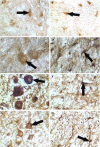Changes in Glial cell line-derived neurotrophic factor expression in the rostral and caudal stumps of the transected adult rat spinal cord
- PMID: 18095158
- PMCID: PMC2270371
- DOI: 10.1007/s11064-007-9536-1
Changes in Glial cell line-derived neurotrophic factor expression in the rostral and caudal stumps of the transected adult rat spinal cord
Erratum in
- Neurochem Res. 2008 Nov;33(11):2375
Abstract
Limited information is available regarding the role of endogenous Glial cell line-derived neurotrophic factor (GDNF) in the spinal cord following transection injury. The present study investigated the possible role of GDNF in injured spinal cords following transection injury (T(9)-T(10)) in adult rats. The locomotor function recovery of animals by the BBB (Basso, Beattie, Bresnahan) scale score showed that hindlimb support and stepping function increased gradually from 7 days post operation (dpo) to 21 dpo. However, the locomotion function in the hindlimbs decreased effectively in GDNF-antibody treated rats. GDNF immunoreactivty in neurons in the ventral horn of the rostral stump was stained strongly at 3 and 7 dpo, and in the caudal stump at 14 dpo, while immunostaining in astrocytes was also seen at all time-points after transection injury. Western blot showed that the level of GDNF protein underwent a rapid decrease at 7 dpo in both stumps, and was followed by a partial recovery at a later time-point, when compared with the sham-operated group. GDNF mRNA-positive signals were detected in neurons of the ventral horn, especially in lamina IX. No regenerative fibers from corticospinal tract can be seen in the caudal segment near the injury site using BDA tracing technique. No somatosensory evoked potentials (SEP) could be recorded throughout the experimental period as well. These findings suggested that intrinsic GDNF in the spinal cord could play an essential role in neuroplasticity. The mechanism may be that GDNF is involved in the regulation of local circuitry in transected spinal cords of adult rats.
Figures








Similar articles
-
Injury-induced accumulation of glial cell line-derived neurotrophic factor in the rostral part of the injured rat spinal cord.Int J Mol Sci. 2012 Oct 19;13(10):13484-500. doi: 10.3390/ijms131013484. Int J Mol Sci. 2012. PMID: 23202963 Free PMC article.
-
Neuroprotection of glial cell line-derived neurotrophic factor in damaged spinal cords following contusive injury.J Neurosci Res. 2002 Aug 1;69(3):397-405. doi: 10.1002/jnr.10303. J Neurosci Res. 2002. PMID: 12125080
-
[TRANSPLANTATION OF NEURAL STEM CELLS INDUCED BY ALL-TRANS- RETINOIC ACID COMBINED WITH GLIAL CELL LINE DERIVED NEUROTROPHIC FACTOR AND CHONDROITINASE ABC FOR REPAIRING SPINAL CORD INJURY OF RATS].Zhongguo Xiu Fu Chong Jian Wai Ke Za Zhi. 2015 Aug;29(8):1009-15. Zhongguo Xiu Fu Chong Jian Wai Ke Za Zhi. 2015. PMID: 26677625 Chinese.
-
Gene transfer of glial cell line-derived neurotrophic factor promotes functional recovery following spinal cord contusion.Exp Neurol. 2003 Oct;183(2):508-15. doi: 10.1016/s0014-4886(03)00130-4. Exp Neurol. 2003. PMID: 14552891
-
Transplants and neurotrophic factors increase regeneration and recovery of function after spinal cord injury.Prog Brain Res. 2002;137:257-73. doi: 10.1016/s0079-6123(02)37020-1. Prog Brain Res. 2002. PMID: 12440372 Review.
Cited by
-
Combined transplantation of GDAs(BMP) and hr-decorin in spinal cord contusion repair.Neural Regen Res. 2013 Aug 25;8(24):2236-48. doi: 10.3969/j.issn.1673-5374.2013.24.003. Neural Regen Res. 2013. PMID: 25206533 Free PMC article.
-
A comparative analysis of differentially expressed genes in rostral and caudal regions after spinal cord injury in rats.Neural Regen Res. 2022 Oct;17(10):2267-2271. doi: 10.4103/1673-5374.336874. Neural Regen Res. 2022. PMID: 35259848 Free PMC article.
-
Activity-dependent increase in neurotrophic factors is associated with an enhanced modulation of spinal reflexes after spinal cord injury.J Neurotrauma. 2011 Feb;28(2):299-309. doi: 10.1089/neu.2010.1594. Epub 2011 Jan 9. J Neurotrauma. 2011. PMID: 21083432 Free PMC article.
-
Neurotrophin expression in neural stem cells grafted acutely to transected spinal cord of adult rats linked to functional improvement.Cell Mol Neurobiol. 2012 Oct;32(7):1089-97. doi: 10.1007/s10571-012-9832-4. Epub 2012 May 10. Cell Mol Neurobiol. 2012. PMID: 22573254 Free PMC article.
-
Injury-induced accumulation of glial cell line-derived neurotrophic factor in the rostral part of the injured rat spinal cord.Int J Mol Sci. 2012 Oct 19;13(10):13484-500. doi: 10.3390/ijms131013484. Int J Mol Sci. 2012. PMID: 23202963 Free PMC article.
References
-
- {'text': '', 'ref_index': 1, 'ids': [{'type': 'PubMed', 'value': '0', 'is_inner': True, 'url': 'https://pubmed.ncbi.nlm.nih.gov/0/'}]}
- Lim PA, Tow AM (2007) Spinal cord injury (SCI) often results in significant neurologic dysfunction and disability. An annual incidence of 15 to 40 traumatic SCI cases per million population has been reported worldwide, and a conservative estimate for Singapore would be 23 cases per million. Ann Acad Med Singap 36(1):49–57 - PubMed
-
- {'text': '', 'ref_index': 1, 'ids': [{'type': 'PMC', 'value': 'PMC6762497', 'is_inner': False, 'url': 'https://pmc.ncbi.nlm.nih.gov/articles/PMC6762497/'}, {'type': 'PubMed', 'value': '11331375', 'is_inner': True, 'url': 'https://pubmed.ncbi.nlm.nih.gov/11331375/'}]}
- Widenfalk J, Lundströmer K, Jubran M, Brené S, Olson L (2001) Neurotrophic factors and receptors in the immature and adult spinal cord after mechanical injury or kainic acid. J Neurosci 21(10):3457–3475 - PMC - PubMed
-
- {'text': '', 'ref_index': 1, 'ids': [{'type': 'DOI', 'value': '10.1126/science.8493557', 'is_inner': False, 'url': 'https://doi.org/10.1126/science.8493557'}, {'type': 'PubMed', 'value': '8493557', 'is_inner': True, 'url': 'https://pubmed.ncbi.nlm.nih.gov/8493557/'}]}
- Lin L-FH, Doherty DH, Lile J, Bektesh S, Collins F (1993) GDNF: a glial cell line-derived neurotrophic factor for midbrain dopaminergic neurons. Science 260:1130–1132 - PubMed
-
- {'text': '', 'ref_index': 1, 'ids': [{'type': 'DOI', 'value': '10.1126/science.7973664', 'is_inner': False, 'url': 'https://doi.org/10.1126/science.7973664'}, {'type': 'PubMed', 'value': '7973664', 'is_inner': True, 'url': 'https://pubmed.ncbi.nlm.nih.gov/7973664/'}]}
- Henderson CE, Phillips HS, Pollock RA, Davies AM, Lemeulle C, Armanini M, Simpson LC, Moffet B, Vandlen RA, Koliatsos VE, Rosenthal A (1994) GDNF: a potent survival factor for motoneurons present in peripheral nerve and muscle. Science 266:1062–1064 - PubMed
-
- {'text': '', 'ref_index': 1, 'ids': [{'type': 'DOI', 'value': '10.1038/373339a0', 'is_inner': False, 'url': 'https://doi.org/10.1038/373339a0'}, {'type': 'PubMed', 'value': '7830767', 'is_inner': True, 'url': 'https://pubmed.ncbi.nlm.nih.gov/7830767/'}]}
- Beck K, Valverde J, Alexi T, Poulsen K, Moffat B, Vandlen R, Rosenthal A, Hefti F (1995) Mesencephalic dopaminergic neurons protected by GDNF from axotomy-induced degeneration in the adult brain. Nature 373:339–341 - PubMed
MeSH terms
Substances
LinkOut - more resources
Full Text Sources
Other Literature Sources

